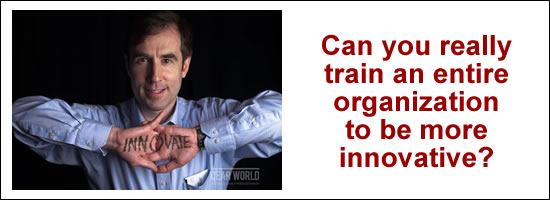 In a popular previous article we looked at the Top 10 Reasons Not to Innovate. In this article we will look at Ten Reasons You Might Suck at Innovation as we explore the following question:
In a popular previous article we looked at the Top 10 Reasons Not to Innovate. In this article we will look at Ten Reasons You Might Suck at Innovation as we explore the following question:
Do you need an innovation intervention?
Unless you feel that your innovation program is a runaway success and exceeding your expectations, the answer might very well be…
yes.
Ten Reasons You Might Suck at Innovation
- Nobody can articulate your definition of innovation (or you don’t have one)
- Nobody can articulate your innovation vision/strategy/goals (or you don’t have them)
- People struggle to tell the story of one or more innovations launched to wide adoption by the organization
- Most of what passes as innovation inside the organization would actually be classified as improvements (not innovation) by people outside the organization
- The organization no longer makes external innovation perspectives available to a wide audience
- Nobody takes the time to participate in our innovation efforts anymore
- Your organization is unable to accept insights and ideas from outside the organization and develop them into concepts that can be scaled to wide adoption
- Innovation program leadership has difficulty getting time on the CEO’s calendar any more
- Your innovation team is trying to do all of the innovating instead of helping to accelerate the innovation efforts of others
- Your pace of innovation is slower than the organizations you compete with for market share, donations, votes, etc.
What is an innovation intervention?
An innovation intervention is a professionally directed, education process resulting in a face to face meeting of consultants, leaders and/or managers with the organization in trouble with innovation. People who struggle with innovation are often in denial about their situation and unwilling to seek treatment. They may not recognize the negative effects their behavior has on themselves and others. Intervention helps the person make the connection between their use of innovation and the problems in their organization. The goal of intervention is to present the innovation user with a structured opportunity to accept help and to make changes before things get even worse.
This may be a somewhat tongue in cheek adaptation of a definition from the substance abuse context*, but it’s almost scary how much I didn’t have to change in the switching of contexts. To make it easier for people to accept help, I came up with the Ten Reasons You Might Suck at Innovation above, and a service offering to hopefully fit within your purchasing authority and your budget (especially if you split it up into two installments of $4,999.99).
Purchasing an Innovation Intervention for $9,999.98 + expenses (or two payments of $4,999.99 + expenses) will get you a three day engagement including:
- A cross-functional and/or cross-site innovation maturity study using my 50 question innovation audit, including analysis of the results, and presentation of the findings
- One or two days on-site:
- Seeing where and how your innovation happens
- Conducting interviews to understand the structure of your innovation programs, processes, and other key elements of your innovation infrastructure
- Walking through past innovation successes and failures
- The balance of the three days will then be spent analyzing the on-site observations and creating a set of actionable recommendations
- Up to five (5) copies of my book Stoking Your Innovation Bonfire for you and your leadership team
- Up to ten (10) sets of my Nine Innovation Roles cards for you and your leadership team
- Up to five (5) copies of my book Charting Change for you and your leadership team
- A 10% discount on any future keynote speeches or innovation training sessions for your organization
- A 10% discount on any Change Planning Toolkit™ site license purchases for your organization
- A 10% discount on any Disruptive Innovation Toolkit™ site license purchases for your organization
Together we’ll get your innovation efforts back on track towards success and build a foundation capable of sustaining continuous innovation. Forward-thinking organizations that haven’t begun an innovation program or a focus on innovation and want to get off to a strong start will be able to leverage the Innovation Intervention service too.
Image credit: calbaptist.edu
*Thanks to the NCADD (National Council on Alcoholism and Drug Dependence, Inc.) for the inspiration
![]() Sign up here to get Human-Centered Change & Innovation Weekly delivered to your inbox every week.
Sign up here to get Human-Centered Change & Innovation Weekly delivered to your inbox every week.

 As a provider of innovation coaching services along with training and
As a provider of innovation coaching services along with training and 